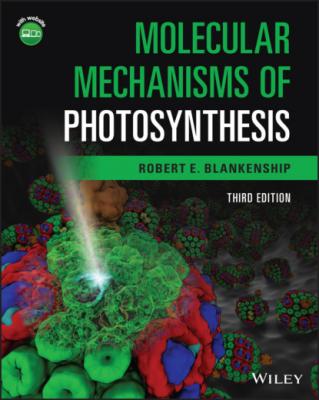Molecular Mechanisms of Photosynthesis. Robert E. Blankenship
Чтение книги онлайн.
Читать онлайн книгу Molecular Mechanisms of Photosynthesis - Robert E. Blankenship страница 2
 7: Reaction centers and electron transfer pathways in oxygenic photosynthetic organisms
7.1 Spatial distribution of electron transport components in thylakoids of oxygenic photosynthetic organisms
7.2 Noncyclic electron flow in oxygenic organisms
7.3 Photosystem II overall electron transfer pathway
7.4 Photosystem II forms a dimeric supercomplex in the thylakoid membrane
7.5 The oxygen‐evolving complex and the mechanism of water oxidation by Photosystem II
7.6 The structure and function of the cytochrome b6f complex
7.7 Plastocyanin donates electrons to Photosystem I
7.8 Photosystem I structure and electron transfer pathway
7.9 Ferredoxin and ferredoxin‐NADP reductase complete the noncyclic electron transport chain
References
7: Reaction centers and electron transfer pathways in oxygenic photosynthetic organisms
7.1 Spatial distribution of electron transport components in thylakoids of oxygenic photosynthetic organisms
7.2 Noncyclic electron flow in oxygenic organisms
7.3 Photosystem II overall electron transfer pathway
7.4 Photosystem II forms a dimeric supercomplex in the thylakoid membrane
7.5 The oxygen‐evolving complex and the mechanism of water oxidation by Photosystem II
7.6 The structure and function of the cytochrome b6f complex
7.7 Plastocyanin donates electrons to Photosystem I
7.8 Photosystem I structure and electron transfer pathway
7.9 Ferredoxin and ferredoxin‐NADP reductase complete the noncyclic electron transport chain
References
15 Chapter 8: Chemiosmotic coupling and ATP synthesis 8.1 Chemical aspects of ATP and the phosphoanhydride bonds 8.2 Historical perspective on ATP synthesis 8.3 Quantitative formulationof proton motive force 8.4 Nomenclature and cellular location of ATP synthase 8.5 Structure of ATP synthase 8.6 The mechanism of chemiosmotic coupling References
16 Chapter 9: Carbon metabolism 9.1 The Calvin–Benson cycle is the primary photosynthetic carbon fixation pathway 9.2 Photorespiration is a wasteful competitive process to carboxylation 9.3 The C4 carbon cycle minimizes photorespiration 9.4 Crassulacean acid metabolism avoids water loss in plants 9.5 Algae and cyanobacteria actively concentrate CO2 9.6 Sucrose and starch synthesis 9.7 Other carbon fixation pathways in anoxygenic phototrophs References
17 Chapter 10: Genetics, assembly, and regulation of photosynthetic systems 10.1 Gene organization in anoxygenic photosynthetic bacteria 10.2 Gene expression and regulation of purple photosynthetic bacteria 10.3 Gene organization in cyanobacteria 10.4 Chloroplast genomes 10.5 Pathways and mechanisms of protein import and targeting in chloroplasts 10.6 Gene regulation and the assembly of photosynthetic complexes in cyanobacteria and chloroplasts 10.7 The regulation of oligomeric protein stoichiometry 10.8 Assembly, photodamage, and repair of Photosystem II References
18 Chapter 11: The use of chlorophyll fluorescence to probe photosynthesis 11.1 The time course of chlorophyll fluorescence 11.2 The use of fluorescence to determine the quantum yield of Photosystem II 11.3 Fluorescence detection of nonphotochemical quenching 11.4 The physical basis of variable fluorescence References
19 Chapter 12: Origin and evolution of photosynthesis 12.1 Introduction 12.2 Early history of the Earth 12.3 Origin and early evolution of life 12.4 Geological evidence for life and photosynthesis 12.5 The nature of the earliest photosynthetic systems 12.6 The origin and evolution of metabolic pathways with special reference to chlorophyll biosynthesis 12.7 Origin and evolution of photosynthetic pigments 12.8 Evolutionary relationships among reaction centers and other electron transport components 12.9 Do all photosynthetic reaction centers derive from a common ancestor? 12.10 The origin of linked photosystems and oxygen evolution 12.11 Origin of the oxygen‐evolving complex and the transition to oxygenic photosynthesis 12.12 Antenna systems have multiple evolutionary origins 12.13 Endosymbiosis and the origin of chloroplasts 12.14 Most types of algae are the result of secondary endosymbiosis 12.15 Following endosymbiosis, many genes were transferred to the nucleus, and proteins were reimported to the chloroplast 12.16 Evolution of carbon metabolism pathways References